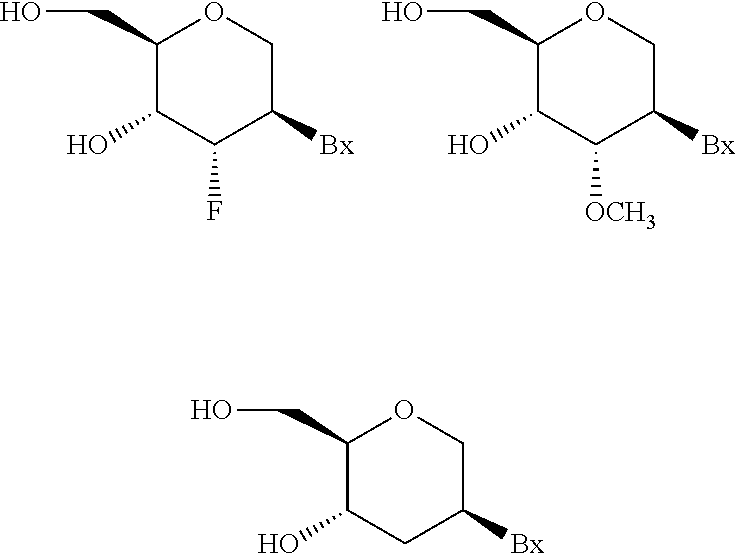Modulation of smrt expression
a technology of smrt and expression, applied in the field of smrt expression modulation, can solve problems such as unfavorable side effects, and achieve the effect of reducing smrt levels
- Summary
- Abstract
- Description
- Claims
- Application Information
AI Technical Summary
Benefits of technology
Problems solved by technology
Method used
Image
Examples
example 1
Antisense Inhibition of Human SMRT: A549 Cells
[0302]The A549 cell line is a well characterized human cell line known to express SMRT and is therefore useful for assessing the effectiveness of antisense oligonucleotides for inhibiting SMRT.
[0303]In accordance with the present invention, a series of oligonucleotides were designed to target different regions of the human SMRT RNA, using published sequences (GenBank accession number AF125672.1, incorporated herein as SEQ ID NO: 1; GenBank accession number NM—006312.1, incorporated herein as SEQ ID NO: 2; and the complement of residues 39001-260000 of GenBank accession number NT—009459.3, representing a partial genomic sequence of SMRT, incorporated herein as SEQ ID NO: 3. The oligonucleotides are shown in Table 1. “Target site” indicates the first (5′-most) nucleotide number on the particular target sequence to which the oligonucleotide binds. All compounds in Table 1 are chimeric oligonucleotides (“gapmers”) 20 nucleotides in length, c...
example 2
Antisense Inhibition of Mouse SMRT: b.END Cells
[0306]Antisense oligonucleotides targeted to a SMRT nucleic acid were tested for their effects on SMRT mRNA in vitro. Cultured b.END cells were transfected using lipofectin reagent with 90 nM antisense oligonucleotide for 4 hours. After a recovery period of approximately 24 hours, RNA was isolated from the cells and SMRT mRNA levels were measured by quantitative real-time PCR. SMRT mRNA levels were adjusted according to total RNA content, as measured by RIBOGREEN®. Results are presented as percent inhibition of SMRT, relative to untreated control cells.
[0307]The chimeric antisense oligonucleotides in Table 2 were designed as 5-10-5 MOE gapmers. The gapmers are 20 nucleotides in length, wherein the central gap segment is comprised of 10 2′-deoxynucleotides and is flanked on both sides (in the 5′ and 3′ directions) by wings comprising 5 nucleotides each. Each nucleotide in the 5′ wing segment and each nucleotide in the 3′ wing segment has...
example 3
Dose-Dependent Inhibition of Mouse SMRT In Vitro
[0309]Inhibition of SMRT mRNA
[0310]Chimeric antisense oligonucleotide having 5-10-5 MOE wings and deoxy gap were designed to target mouse SMRT (GENBANK Accession No. AK147394.1), incorporated herein as SEQ ID NO: 4. The antisense oligonucleotides were evaluated for their ability to reduce SMRT mRNA in primary mouse hepatocytes.
[0311]Primary mouse hepatocytes were treated with increasing concentrations of antisense oligonucleotides, as shown in Table 3, for a period of 4 hours. RNA was isolated from the cells after 24 hours and SMRT mRNA levels were measured by quantitative real-time PCR, as described herein. Mouse SMRT primer probe set RTS2818 was used to measure mRNA levels. SMRT mRNA levels were adjusted according to total RNA content as measured by RIBOGREEN®. Several oligonucleotides exhibited dose-dependent reduction of murine SMRT mRNA levels.
TABLE 3dose-dependent reduction of mouse SMRT mRNA levels4.688nM9.375 nM18.75 nM37.5 nM7...
PUM
| Property | Measurement | Unit |
|---|---|---|
| waist circumference | aaaaa | aaaaa |
| waist circumference | aaaaa | aaaaa |
| body weight | aaaaa | aaaaa |
Abstract
Description
Claims
Application Information
 Login to View More
Login to View More - R&D
- Intellectual Property
- Life Sciences
- Materials
- Tech Scout
- Unparalleled Data Quality
- Higher Quality Content
- 60% Fewer Hallucinations
Browse by: Latest US Patents, China's latest patents, Technical Efficacy Thesaurus, Application Domain, Technology Topic, Popular Technical Reports.
© 2025 PatSnap. All rights reserved.Legal|Privacy policy|Modern Slavery Act Transparency Statement|Sitemap|About US| Contact US: help@patsnap.com


